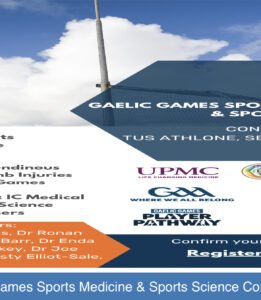
Conference to tackle lower limb injuries in Gaelic Games:
By John Harrington
Diagnosing lower limb injuries and returning to play after them will be the themes of the Gaelic Games Sports Medicine and Sports Science Conference which will take place in TUS Athlone on Saturday, September 2.
The aim of the conference is to bring together people who are delivering sports science and sports medicine to inter-county teams across all codes in order to build a community of practice, and those who are interested in attending can register HERE.
“What we’re trying to achieve is to facilitate more open lines of communication among our practitioners within sports medicine especially, but also within the other facets of a sports science backroom team such as nutrition, S&C, sports psychology, et cetera, in the inter-county game and across the four codes which is key,” says Eamon O’Reilly of the Gaelic Games Sports Science Working Group.
“The big thing for us is that we’re starting to develop a community of practice across all four codes rather than just having pockets of GAA, LGFA and Camogie Association medical team representatives here and there.
“We’re viewing this conference as being the starting point of a larger body of work that we’re going to undertake over a number of years where we really start supporting our sports medicine practitioners and increase the information we are providing these practitioners with in terms of game demands, injury rates, and other factors that will help them enhance athlete performance and welfare.”
The conference schedule, which can be downloaded at the end of this article, will feature best in class Irish sports science and sports medicine practitioners as well as some very highly regarded international speakers.
“We’ve got some fantastic sports medicine practitioners and sports science practitioners in this country, we’re really blessed with excellent practitioners across the board, and the conference is about sharing their expertise and knowledge and suplementing that with some of the figures that will be coming from an international point of view,” says O’Reilly.
“If you look at the speakers who are coming, there are international experts from the UK and Australia, and these people are world renowned when it comes to their own individual areas.
“We have Professor Kirsty Elliot-Sale speaking on female physiology, Professor Ian Jeffreys on return to sprinting, we have Jack Hickey from Australia who has published extensively in hamstring rehab, and that’s not even getting into our own practitioners who are working abroad like David Breen who is highly regarded both in rugby and soccer circles in addition to being an elite hurler himself.
“And then, obviously, we’ve got our own practitioners who are living and working within the country who are included in the conference. Dr Ronan Kearney, Dr Enda White, Dr Joe Jordan, and Jessie Barr.
“When putting it all together we’re looking at all the various aspects of the conference theme which is diagnosing lower limb injuries and returning to play post those injuries.
“The morning-time will focus on the diagnostic side and the afternoon will focus on the rehab and return to play side.
“The reason we picked this particular topic was based on the research and injury database work that we have compiled to date, which has shown that musculotendinous injuries of the lower limbs are the dominant injury type in Gaelic Games across all four codes.”
This week’s conference will build further on the great work done by the Gaelic Games Sports Science Working Group which earlier this year launched a specially designed framework for the development and provision of sports science at club and county level across Gaelic Games.
“We will be introducing some of the work we’ve done with the Gaelic Games Sports Science Working Group and primarily we’ll be looking at the physio and rehab side in terms of what’s coming down the line,” says O’Reilly.
“Also, we’ll be really looking to engage our sports science and sports medicine practitioners on the benefits of our new injury database and how we can utilise the information from this to improve return to play pathways for our athletes, inform practice on how game demands impact our athletes, improve our ability to treat injuries, and get a broader picture of what’s happening within Gaelic Games across the four codes.
“The big thing is that we’re looking to create that community of practice. We have some exciting things on the way in terms of sports medicine within Gaelic Games and we’ll be looking to incorporate these into our sports medicine and sports science community as we progress.”

